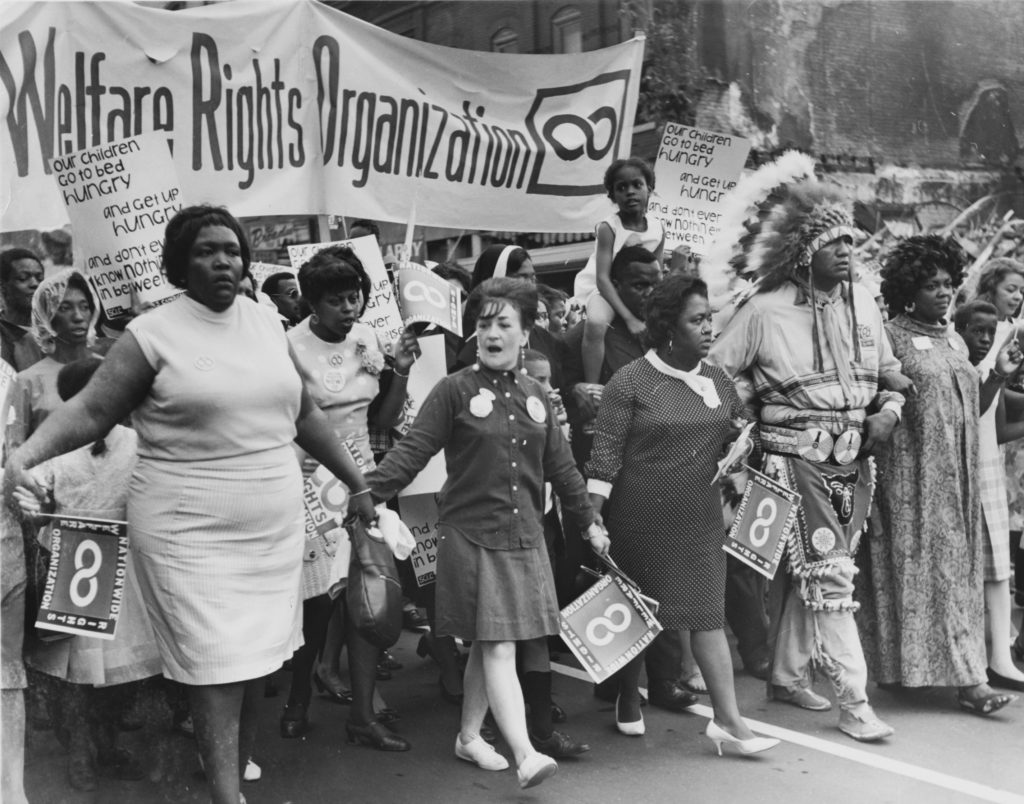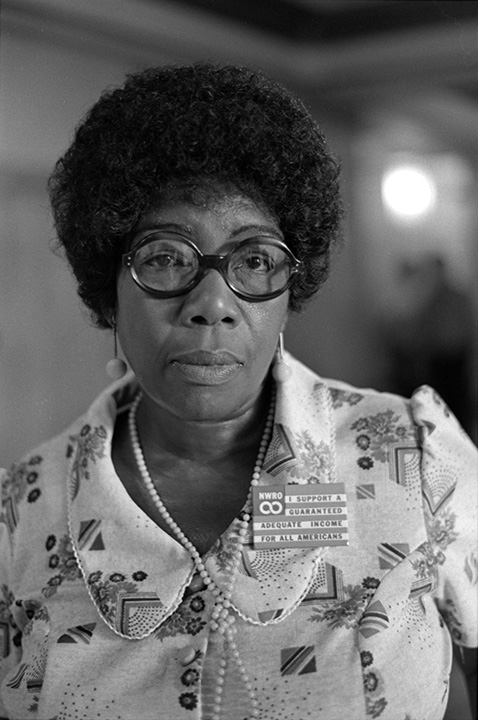Ethel Mae Matthews and the Emmaus House in Atlanta

Fifty years ago, Emmaus House opened its doors for the first time. Located in Peoplestown, a deprived neighborhood southeast of downtown Atlanta, Emmaus House is a community advocacy and support center. Still in operation today, it was established by Father Austin Ford, a white Catholic priest with the Diocese of Atlanta. The center was swiftly embraced by the predominantly African American local community. Although Emmaus House was in some ways typical of the Great Society-era antipoverty organizations that developed during the mid-to-late 1960s, it was unusual in the urban South, especially in Atlanta. Local black community members ran the center’s operations alongside white church staff members and a handful of volunteers (often white northern college students).1
In the years that followed, Emmaus House became the wellspring of a distinctive Black Power-inflected grassroots social and economic justice activism shaped strongly by the feminist politics of local poor and working class black women. No one did more to define that activism than Ethel Mae Matthews, a local black mother and welfare recipient who, over three decades from the late 1960s onward, became one of the most committed and important advocates for social and economic justice in Atlanta.
In July 1968, following a visit from a National Welfare Rights Organization (NWRO) speaker, Emmaus House became the launching pad for a vibrant local welfare rights movement. It oversaw the formation of the first local welfare rights group, who chose Matthews as their leader. The group’s membership quickly expanded to over 150. Emmaus House provided vital organizational support that resulted in the formation of numerous NWRO chapters in disadvantaged black neighborhoods across Atlanta. The center provided both the space for meeting at their headquarters and transportation to and from those meetings for residents.
The following year, Emmaus House worked with several local black ministers and residents in dozens of Atlanta’s housing projects to establish Tenants United for Fairness (TUFF), a city-wide tenants’ rights activist group. Like many local welfare rights groups, TUFF was predominantly female-led. In the years that followed, TUFF’s battles with the Atlanta Housing Authority resulted in significant victories for local blacks. These included improved leases, better housing code enforcement, and the establishment of a grievance review procedure that was the first of its kind (and that later became a national requirement in public housing).

Emmaus House also ran numerous programs to support the local community, including a food cooperative for several years in the early 1970s. It also offered free baby feeding and food surplus programs, not dissimilar to the “community survival” programs run by the Black Panther Party. In fact, Emmaus House had other direct links to the Black Panthers. Gene Ferguson, a leading figure at the center, was also a member of the small but committed cadre of local Black Panther Party activists. Along with Columbus Ward (another Black Panther), Ferguson taught local children at Emmaus House about black history and ran numerous other programs. For example, the “Liberators,” an after-school children’s club, provided meals and educational field trips to city government buildings and museum, and offered arts and drama classes for local youngsters.
The center also housed what became known as the Poverty Rights Office (PRO), which helped residents deal with practical problems. As one staff member explained, “the kind of work that they [the PRO] did, we did on a walk-in basis: somebody’s electricity was cut off, somebody needed to apply for welfare or get Social Security benefits, somebody was having a housing issue, all sorts of things like that, and we’d just go out and do.” Beyond providing community support, the PRO played an especially important role in the development of local activism through their printing and distribution of the Poor People’s Newspaper. Appearing every six weeks for well over a decade, the Poor People’s Newspaper published articles that enumerated and explained local people’s rights and highlighted important developments. Ethel Mae Matthews’s regular opening columns were an important ingredient in her development into a well-respected local leader.2
Emmaus House worked to help locals win greater political power as well. In addition to voter registration and education work, the organization sponsored candidates from the community to run for local office and supported their campaigns. In 1969 and 1973, Ethel Mae Matthews ran for a seat on the city council. Although unsuccessful on both occasions, her candidacy led to the removal of the city’s $500 candidate filing fee requirement, which, she argued, effectively excluded the poor from running in local elections. In 1972, local black resident and Emmaus House volunteer Margret Griggs was persuaded by Father Ford to run for election to the Board of Education, which she did successfully later that year.3
Ethel Mae Matthews and Emmaus House also fought to improve local black children’s education, pioneering a community struggle to integrate the city’s schools. Following the Brown decision in May 1954, Atlanta’s white-controlled school board dedicated itself to minimizing the ruling’s impact on the racial makeup of the city’s public schools. In October 1969, the Supreme Court’s decision in Alexander v. Holmes forced the Board of Education to adapt its policy once more. The school board responded with a new school desegregation plan that included a deliberately unpublicized provision. If a minimum of thirty children signed up for transfer and their parents arranged their transportation, students in schools where they were in a majority could apply for transfers to schools where they would be in a minority. The organizational burden this provision placed on parents was specifically designed to deter poor and working-class black Atlantans from taking advantage of it.

Recognizing local parents’ deep concerns about bettering their children’s education, Emmaus House got to work. Ethel Mae Matthews and her fellow community activists signed nearly four hundred local black youngsters up for school transfers and established their own busing service to take the children to their new schools. This effort was more than just an attempt to improve local children’s education by targeting the well-resourced elementary schools that served North Atlanta’s wealthy white neighborhoods. It was also a symbolic challenge to the racial and economic dimensions of educational inequality in the city. Despite the anger of many white parents in North Atlanta (including some Emmaus House donors who withdrew their support in protest), the busing program was a success at a time when busing was under widespread attack from white (and some black) detractors.
The Emmaus House became a vibrant center of black community activism that evolved over time. What began in mid-1968 as welfare rights and tenants’ rights activism became a much broader struggle for, and a commitment to, social and economic justice. As one Emmaus House worker remembered, at the start, local activists—often led by Matthews—focused on “basic rights such as obtaining higher welfare payments and using formal grievance hearings to dispute termination or reduction of benefits or other improper decisions by their caseworkers.” As they “developed confidence in speaking out, and other leadership capacities,” they came to address other issues such as “better pay for black workers, securing better housing and food, and electing better government officials.”
As historian Rhonda Williams’ path-breaking work on black female public housing tenants’ activism in Baltimore has suggested, this community activism was influenced by the grassroots organizing spirit and philosophy evinced by radical Black Power groups like the Black Panthers. It was part of a Black Power-oriented agenda primarily concerned with transformative social and economic justice politics, the redistribution of power and resources from the top-downwards, the democratization of local institutions, and resisting racial and gender oppression. Unlike more moderate or conservative visions of Black Power, it attributed far less value to the pursuit of economic nationalism and put less stock in the symbolic importance of black ownership or control. Black empowerment—political or economic—was prized only where it served the greater cause of reforming and democratizing American institutions and society in the pursuit of social, economic, and racial justice for all. Perhaps most significantly, it reflected a black working-class feminist ideology that strongly emphasized reproductive rights. This community activism celebrated motherhood and demanded that the work of childrearing be officially recognized as a form of labor and properly compensated (an argument that was bound up with debates over the welfare reform and demands for a guaranteed minimum income during the late 1960s and early 1970s).
As Emmaus House marks its half centenary, it is celebrating fifty years of remarkable activism. Contrary to dominant declensional narratives of the 1960s and 1970s black freedom struggle, Matthews and her fellow activists at Emmaus House vigorously continued to fight race and gender inequality in the city and state in the decades that followed. When Matthews passed away in 2005 at the age of 72, one writer remembered her as “a loud and persistent voice for the poor, the elderly and children. For decades, she was a leader and participant in countless marches and sit-ins; stood in front of bulldozers to stop the destruction of a community center; confronted mayors, governors and presidents over their policies that hurt the poor.” As the current retrospective exhibition at Emmaus House makes clear, the memory of the center’s most important activist is being kept alive for future generations.
- For more about Emmaus House and the history of Peoplestown, visit the website of the Peoplestown Project run by Dr. Lee-Ann Lands. ↩
- The Poor Peoples Newspaper repository can be found at the Atlanta History Center, Kenan Research Center, Muriel Lokey Papers, MSS 967. ↩
- “Mrs. Matthews Sues to Enter Council Race,” Atlanta Daily World, May 3, 1973, p. 1. ↩

Tom Adam Davies’ article reminded me of the impact Emmaus House programs on people’s lives and struggles for transformative change. Most participants in Emmaus Housse programs in the sixties and seventies had a strong sense of personal and collective efficacy, as evident in the work of the indomitable Ms. Ethel Mae Matthews.
I noted an error. Father Austin Ford resigned as the director of the St. Bartholomew Episcopal Church to work with a cross section of community members to establish the Emmaus House. Also, a few African American students served as interns. I am proud to have worked with Austin Ford, “Sister,” Gene Fergurson, Columbus Ward, Ms. Ethel Mae Matthews, and many others.